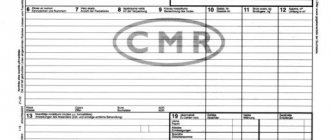The TN VED code stands for the code of the commodity nomenclature of foreign economic activity. It is indicated in customs declarations when importing and exporting goods into the country. Selecting it for a specific product is not so easy. But after reading this article, you will definitely cope with it.
Remember that customs authorities are not to be trifled with, and all your actions when importing or exporting products must comply with the law. If problems arise with this civil service, we advise you to contact a professional. If you do not have legal knowledge in this area, the consequences can be very serious, including confiscation of property and huge fines.
An experienced customs lawyer will solve your problem and minimize risks as quickly as possible.
Do you want to figure it out, but don’t have time to read the article? Lawyers will help
Entrust the task to professionals. Lawyers will complete the order at the cost you specify
Solve the issue >
HS code: what is it?
The abbreviation TN VED EAEU refers to the commodity nomenclature of the Eurasian Economic Union . The basis for its creation was the Harmonized System of the World Trade Organization, which is used in the European Union and approximately 150 other countries around the world. A common framework at the international level makes it possible to optimize the design and implementation of procedures, maintain reporting and overcome barriers between countries in tariff and non-tariff regulation.
The essence of the classifier is that each product or group of goods is assigned a unique code and a customs duty is assigned. This system is used to achieve unambiguous identification of goods, subsequent collection of customs duties and as a simplification for automated processing of customs declarations.
The structure of the product range includes the following elements:
- Classification of goods with code designations.
- Notes on individual items with inclusions, exclusions from groupings, as well as coding recommendations and explanations.
- OPI TN VED – basic rules of interpretation.
All parts complement each other, so the declarant must take into account their information for correct classification and assignment of a code.
Why is the code defined?
To understand why code is defined, let’s understand the concepts of the process itself. So, each product receives a ten-digit HS code when crossing the Russian border. The code is a combination of numbers written on the international transport bill of lading (CMR), which comes along with the cargo. Determining and assigning a code to a product is called classification.
The declarant must classify his cargo and, at the customs clearance site, enter this digital combination into the cargo customs declaration. All this is done in order to correctly calculate the amount of customs duties and the application of non-tariff regulation measures. It is the HS code that determines the rate for payments to the state budget.
What it is?
The Commodity Nomenclature of Foreign Economic Activity is an official classifier that contains the information required for declaring goods. The customs code includes ten digits containing characteristics of the product class, its variety, subgroup, etc. The HS codes we now know were developed in parallel with the creation of the EurAsEC Customs Union. Since then, they have been actively used by customs officers and participants in foreign trade activities in customs operations. The HS Classifier is essentially a domestic variation of the Harmonized System, which is widely used in Europe. Thanks to HS codes, customs authorities compile trade statistics. Based on the code, the customs duty for the goods is determined, and a set of permits required for its successful transportation across the border is generated.
How to determine the code
The method for determining a digital combination can be divided into three steps.
- First : the declarant needs to carefully read the technical documentation provided by the supplier or manufacturer and determine the main parameters of the classification of the goods. As a rule, the correct code is already indicated in the received papers.
- Second step : review the classifications in the Decision of the Council of the Eurasian Economic Commission dated July 16, 2012 N 54 (as amended on January 14, 2020) “On approval of the unified Commodity Nomenclature for Foreign Economic Activity of the Eurasian Economic Union and the Unified Customs Tariff of the Eurasian Economic Union.”
- Third step: select the appropriate sections for the product according to its characteristics from general to specific. Example: for aluminum concentrates the numerical designation 2606 00 000 0 is provided. They are in groups 25-27 “Mineral products”, namely in group 26 “Ores, slag and ash”.
The method presented above is not the only one. You can seek help from a private organization involved in customs clearance, or from the customs authorities with an official request. However, in this case you will have to pay a state fee and wait for an official response.
Also, a subject of foreign economic activity has the right to apply to the local Chamber of Commerce and Industry (CCI). There they will conduct an examination and classify the samples (not for free, of course). It is important to understand that the final decision to accept or not accept the goods code according to the Commodity Classification of Foreign Economic Activity, which was selected by the declarant, always remains with the customs authorities.
Note. Selecting the EAEU HS code is a responsible task, since the process of goods registration depends on its accuracy. Errors lead to problems with customs authorities and other unpleasant consequences for the declarant.
Why is it important to define it?
Please note that customs clearance of different HS codes (goods) requires certain additional documents. Often the opinions of the participant in foreign economic activity (Foreign Economic Activity) and customs officers regarding the choice of code do not agree. The latter make their own classification decision. As a result, the final amount may be completely different from what the declarant expected.
In case of serious disagreements, the subject of foreign trade activities will have to contact a higher customs authority or court to defend their interests. However, it is quite possible that the outcome of the case will not turn out in his favor, and this will once again increase the time frame for customs clearance.
Classification of goods
For the commodity classification of imported products, the World Customs Organization introduced a special commodity nomenclature for foreign economic activity of the Customs Union, or in short, the Commodity Nomenclature of Foreign Economic Activity of the Customs Union. This classifier is used by participants in foreign economic activity and state customs authorities to conduct commodity transactions at customs. The code assigned to the product determines the customs duty when transporting the product abroad.
The nomenclature of foreign economic activity dates back to 1988, during the accession of the USSR to the International Convention on the Harmonized System for Description and Coding of Goods. After the collapse of the Union, the product nomenclature changed twice: in November 1995, a new HS of the Commonwealth of Independent States was adopted. An agreement on a unified nomenclature for 12 CIS countries was signed in 1997. After the creation of the EAEU Customs Union, a new nomenclature was introduced, which is still in effect today.
How to decrypt it
The nomenclature of the Eurasian Economic Union (EEC) contains codes for different product groups. HS codes include 10 characters, namely XXXX XX XXX X. They are divided into 21 sections and 97 groups. Each number in the ten-digit combination corresponds to a homogeneous product.
The transcript (code structure) looks like this:
- the first two characters are the product group (84 – Nuclear reactors, boilers, equipment and mechanical devices; their parts);
- four characters – commodity item (8458 – Metal-cutting lathes (including multi-purpose lathes);
- six characters – product subitem (845811 – With numerical program control);
- the first eight digits – subposition of the Commodity Nomenclature of Foreign Economic Activity (84581141 – Single-spindle);
- 10 characters – full product code – subposition of the Commodity Nomenclature of Foreign Economic Activity (8458114109 – Other).
To determine the code, basic data is required about the material of manufacture, the degree of processing, functions and purposes of the object.
Classification according to the Commodity Nomenclature of Foreign Economic Activity of the EAEU
Main criteria for classification according to the Commodity Nomenclature of Foreign Economic Activity
1. The material from which the product is made.
2. The function that this product performs.
3. Additional criterion: degree of processing.
Practical algorithm of actions for classification according to the Commodity Nomenclature of Foreign Economic Activity
First of all, we determine the trade, commercial or other traditional name of the declared product, and carefully study its characteristics and properties. From the HS codes selected by the program, we classify them using interpretation rules in strict sequence.
The text of the GPI (basic rules of interpretation), like all texts of the nomenclature, is translated and very difficult to understand, so below we provide the text of the GPI, adapted for practical purposes, with examples.
OPI 1
When choosing a code, you should be guided by the texts of product items, subitems, sub-items and notes to them, and the names of sections, groups and subgroups are for reference only. It is necessary to carefully study the above texts.
For example: 731700 “Nails, buttons, drawing pins ... with or without heads of other materials, except products with copper heads”; 7415 "Nails, tacks, thumbtacks, staples and similar articles of copper or ferrous metal with copper heads."
The vast majority of products are classified according to OPI 1 through the so-called “basket” codes – “other”.
OPI 2
Helps classify complex products:
a) an unfinished product that has the basic properties of a finished product must be classified as a finished, completed product.
For example, a “bicycle without a saddle” is classified as a finished product - a bicycle (871200);
This rule also applies to blanks that must have a certain shape for the future product.
Products that are not assembled/disassembled are classified as assembled.
For example, “A wooden cabinet disassembled for ease of transportation” is classified as a “cabinet” (940350).
It should be noted that the complexity of assembly is not taken into account.
At the same time, the product may be submitted for customs clearance in incomplete and unfinished form.
“A bicycle without a saddle and disassembled for ease of transportation” is still a bicycle (871200).
b) mixtures of any substance belong to the same position as the substance itself;
Example: “A leather jacket is made of genuine leather, with a textile lining and buttons” by virtue of GPI 2 (b) in heading 4203: “garments and clothing accessories made of genuine leather.”
Let's look at the difficulties of using OPI 2 (b) using an example:
"Vegetable oil consisting of 85% sunflower oil (1512) and 15% rapeseed oil (1514) for food purposes." The declarant, in accordance with GPI 2 (b), classified the product as sunflower oil - position code 1512, which is an error, ignored GPI 1 (inattentive reading of the texts of commodity items). The correct position for this mixture is 1517: “...; mixtures and prepared products from animal and vegetable fats suitable for human consumption..."
OPI 3
Regulates the classification of multi-component goods and mixtures when there is a choice between several equivalent codes:
a) it is recommended to choose the position that more specifically describes the product;
“Tufted carpet for automobile interiors” may be classified in headings 8708 (parts and accessories of motor vehicles) and 5703 (carpets and other tufted floor coverings). In accordance with OPI 3 (a), this product must be classified in position 5703.
b) mixtures, multi-component products and sets must be classified according to the part or component that gives them the main property (applies to mixtures, combined products, sets for retail sale);
An example of a multi-component product made from various materials: “Cat’s eye, consisting of a metal stand (body) - 7326, into which glass is inserted - 7019.” The main property of this product is given by glass, so we classify it by glass.
A set for retail sale is goods consisting of at least two items of different product headings, assembled together to perform one purpose or one job and packaged for retail sale. Classified by the component that provides the main property to the set.
“Set: spaghetti, cheese, spices and packaging box” should be classified as spaghetti in group 19 of the HS.
c) when it is impossible to use all the previous rules, the product is assigned to the last position in ascending order (of those between which you need to choose).
“Salted-frozen fish caviar, not ready for use”, frozen caviar – 030391, salted caviar – 030520. Both salt and freezing are necessary to preserve the product and give it the necessary qualities. In accordance with OPI 3 (c), the position is selected - 030520.
OPI 4
If the first three rules are not applicable, the product is classified in the position closest in terms of materials and properties. This rule is practically not applied.
OPI 5
Explains the classification of containers and packaging:
a) covers and cases for specific products are classified together with those products if they are of the appropriate shape and are generally sold together;
an exception is when the container gives the product its main property.
“Silver box in which tea is packaged” is classified separately silver box, separately tea; “Mobile phone in a case” should be classified separately as a case and separately as a phone, since a case can be sold without a phone.
b) packaging that can be reused is excluded from this rule.
It is used when a product item has been established (4th character) and further detailing of the code is necessary. When classification at the subposition level is carried out in accordance with the texts of the subpositions, the use of OPI No. 2–5 is allowed. Subpositions of only one level (the same number of hyphens) are comparable to each other.
It should be noted separately the special use of punctuation marks in the texts of the Commodity Nomenclature of Foreign Economic Activity:
- comma – simple listing of goods;
- semicolon ";" - reads like a period.
- colon – continuation of the detailing of a position or subposition at a subsequent level.
Let’s take, for example, “a case for business papers made of aluminum” and “a cigarette case made of aluminum.” These goods are listed in the text of position 4202 of the HS, but the case should be classified in position 4202, and the cigarette case in position 7616. The reason for this is the punctuation mark “;”. The text of the position is divided by a sign into two parts: one part, where the material from which the product should be made is not indicated (the case is listed), and in the other part after “;” Lists products that must be made only from leather, plastic sheets, cardboard and textiles.
It should be noted that the classification of simple goods does not cause any particular difficulties for declarants. It is difficult to classify multicomponent products, with complex technical, physical and chemical characteristics, multifunctional, the classification of which requires special knowledge in various fields of activity. In these cases, we advise you to take the opportunity to obtain a preliminary classification decision from the regional customs departments. The procedure for obtaining these decisions is described in detail in the Administrative Regulations, approved by Order of the Federal Customs Service of Russia dated April 16, 2020 No. 375. You can also familiarize yourself with the recommendations for obtaining a classification decision.
To correctly classify goods, we recommend using various reference materials:
- explanations to the Commodity Nomenclature of Foreign Economic Activity;
- collection of preliminary decisions on the classification of the Federal Customs Service of Russia and the EEC;
- Order of the Federal Customs Service of Russia dated August 15, 2014 No. 233-r on the classification of certain goods (similar orders were adopted by the customs authorities of Kazakhstan and the Republic of Belarus);
- expert opinions from the websites of customs laboratories;
- online service “Products and Codes”, which allows you to take advantage of practical experience in declaration.
It is convenient to classify products according to the Commodity Nomenclature of Foreign Economic Activity of the EAEU using the reference book “Commodity Nomenclature of Foreign Economic Activity” in Alta-Soft software products: Alta-GTD, Tax, Article, Customs documents, Alta-PI, Alta-SVH. The directory includes not only a list of current HS codes and corresponding item names and codes, but also an alphabetical subject index, as well as Explanations and Notes, which helps to quickly and correctly classify the desired product. When determining the code, you can also use the list of preliminary classification decisions of the Federal Customs Service of Russia. The “Products and Codes” and “Code Selection” applications allow you to analyze under what codes a similar product previously crossed the border. All this, together with the use of basic rules of interpretation, allows you not only to quickly and correctly determine the product code according to the Commodity Nomenclature of Foreign Economic Activity, but also to justify your choice in case of disputes with customs authorities.
Code structure
The first thing the code structure begins with is sections. They are designated by Roman numerals (total section XXI) and are formed in accordance with industries.
The second is groups. They are designated by two Arabic numerals (99 groups in total, of which 78, 98, 99 are reserved for the future) and are formed in accordance with:
- with the materials from which the goods are made;
- with the functions that products perform;
- with the degree of processing (the higher the level of processing, the higher the group number), example: /living tree – 06 group/ —— /log – 44 group/ —— /stool – 94 group/.
Third - subgroups. They are also designated by Roman numerals (33 in total, not found in all groups).
Fourth – commodity items. They are indicated by the first four Arabic numerals (approximately 1220 in total) and are formed from simple to complex. For example, /log – 4403/ —— /board – 4407/ —— /box – 4415/.
Fifth - subposition. It is indicated by the first six Arabic digits (approximately 5000 in total, corresponding to the HS product code).
The sixth is a subposition, which is designated by ten Arabic numerals, the actual digital code of the Commodity Nomenclature of Foreign Economic Activity.
Seventh, the basic rules of interpretation. This is an integral part of the Commodity Nomenclature of Foreign Economic Activity and has legal force. There are 6 rules in total, and they are applied in strict sequence from 1 to 6 (with the exception of rule 5).
Eighth – notes on sections and groups. They have legal force and indicate what is/is not included in this section/group.
Independent search
Responsibilities for assigning codes for the commodity nomenclature of foreign economic activity are assigned to the declarant, however, when submitting a declaration at the customs post, the Customs Service carries out a thorough check for the authenticity of the commodity codes. When classifying a product, you need to rely on its main criteria:
- Material of manufacture.
- Product functions.
- The degree of processing (manufacturing) of the product.
- Dimensions and weight.
The search for a code for a specific product is carried out using special identification services (classifier of HS codes). If the RF TN FEA reference book does not contain detailed information about the product you are interested in, you should select a homogeneous product group according to the CU FEA nomenclature. Also, when using the CU FEACN code classifier, it is necessary to take into account the basic rules for interpreting codes, their nomenclature part and notes on product sections. Evasion of the laws of the Customs Union is subject to prosecution under the law (administrative liability).
If you require the services of a customs broker: we recommend contacting the companies https://buroimporta.ru or https://import-v-rossiu.ru, they will advise you as simply and clearly as possible. When delivering goods, our company uses the website https://dostavka-asia.ru
Application of codes
These digital combinations are used for documents such as:
- universal subordinate document;
- customs declaration;
- document on compliance with TR CU and TR CU of the EAEU (if necessary);
- invoice.
This is interesting:
Changes to Federal Law 289 on customs regulation and what to expect from them
What is a customs terminal: functions, services provided and location in major cities
HS codes
8523 - Discs, tapes, solid-state non-volatile storage devices, smart cards and other media for recording sound or other phenomena, whether or not recorded, including matrices and master disks for making discs, other than articles of Chapter 37:
| 8523 | Discs, tapes, solid-state non-volatile storage devices, smart cards and other media for recording sound or other phenomena, whether recorded or not, including matrices and master disks for making discs, other than articles of Chapter 37: |
| — magnetic media: | |
| 8523 21 000 0 | — — cards containing a magnetic strip |
| 8523 29 | - - other: |
| — — — magnetic tapes; magnetic disks: | |
| 8523 29 100 | - - - - unwritten: |
| — — — — — magnetic tapes: | |
| — — — — — — width no more than 4 mm: | |
| 8523 29 100 1 | — — — — — — — in cassettes |
| 8523 29 100 2 | — — — — — — — in rolls |
| 8523 29 100 3 | — — — — — — — others |
| 3523 29 100 4 | — — — — — — — more than 4 mm wide, but not more than 6.5 mm |
| — — — — — — width more than 6.5 mm: | |
| 8523 29 100 5 | — — — — — — — in cassettes |
| 8523 29 100 6 | — — — — — — — width no more than 100 mm in rolls |
| 8523 29 100 7 | — — — — — — — more than 100 mm wide in rolls |
| 8523 29 100 8 | — — — — — — — others |
| 8523 29 100 9 | — — — — — — magnetic disks |
| - - - - others: | |
| 8523 29 210 | — — — — — to reproduce phenomena other than echo or image: |
| 8523 29 210 1 | — — — — — — magnetic tapes |
| - - - - - - others: | |
| 8523 29 210 2 | - - - - - - - with the recording of data or commands used in computers |
| 8523 29 210 9 | — — — — — — — others |
| 8523 29 250 | - - - - - to reproduce commands, data, sound and images written in machine-readable binary form and which can be manipulated or interactively accessed by a user using a computer: |
| — — — — — — magnetic tapes: | |
| — — — — — — — width no more than 4 mm: | |
| 8523 29 250 1 | — — — — — — — — in cassettes |
| 8523 29 250 2 | — — — — — — — — in rolls |
| 8523 29 250 3 | — — — — — — — — others |
| 8523 29 250 4 | — — — — — — — more than 4 mm wide, but not more than 6.5 mm |
| — — — — — — — width more than 6.5 mm: | |
| 8523 29 250 5 | — — — — — — — — in cassettes |
| 8523 29 250 6 | — — — — — — — — in rolls |
| 8523 29 250 7 | — — — — — — — — others |
| 8523 29 250 8 | — — — — — — magnetic disks |
| 8523 29 290 | — — — — — others: |
| — — — — — — magnetic tapes: | |
| — — — — — — — width no more than 4 mm: | |
| 8523 29 290 1 | — — — — — — — — in cassettes |
| 8523 29 290 2 | - - - - - - - - in rolls |
| 8523 29 290 3 | — — — — — — — — others |
| 8523 29 290 4 | — — — — — — — more than 4 mm wide, but not more than 6.5 mm |
| — — — — — — — width more than 6.5 mm: | |
| 8523 29 290 5 | — — — — — — — — in cassettes |
| 8523 29 290 b | — — — — — — — — in rolls |
| 8523 29 290 7 | — — — — — — — — others |
| 8523 29 290 8 | — — — — — — magnetic disks |
| 8523 29 900 0 | - - - others |
| 8523 40 | — optical media: |
| - - unwritten: | |
| 8523 40 110 0 | — — — disks for laser reading systems with a recording capacity of no more than 900 megabytes, except erasable ones |
| 8523 40 120 0 | — — — disks for laser reading systems with a recording capacity of more than 900 megabytes, but not more than 18 gigabytes, except erasable ones |
| 8523 40 130 0 | - - - others |
| - - other: | |
| — — — disks for laser reading systems: | |
| 8523 40 200 0 | — — — — for reproducing phenomena other than sound or image |
| — — — — for audio playback only: | |
| 8523 40 310 0 | — — — — — with a diameter of no more than 6.5 cm |
| 8523 40 390 0 | — — — — — with a diameter of more than 6.5 cm |
| - - - - others: | |
| 8523 40 400 0 | - - - - - for reproducing commands, data, sound and images written in machine-readable binary form and which can be manipulated or interactively accessed by a user using a computer |
| — — — — — others: | |
| 8523 40 510 0 | — — — — — — digital universal discs (DVDs) |
| 8523 40 590 0 | - - - - - - others |
| - - - others: | |
| 8523 40 700 | — — — — to reproduce phenomena other than echo or image: |
| 8523 40 700 1 | - - - - - with the recording of data or commands, used in computers |
| 8523 40 700 9 | - - - - - others |
| 8523 40 910 0 | - - - - to reproduce commands, data, sound and images written in machine-readable binary form and which can be manipulated or interactively accessed by a user using a computer |
| 8523 40 990 0 | - - - - others |
| — semiconductor carriers: | |
| 8523 51 | — — solid-state non-volatile data storage devices: |
| 8523 51 100 0 | - - - unrecorded |
| - - - others: | |
| 8523 51 700 | — — — — to reproduce phenomena other than echo or image: |
| 8523 51 700 1 | - - - - - with the recording of data or commands, used in computers |
| 8523 51 700 9 | - - - - - others |
| 8523 51 910 0 | - - - - to reproduce commands, data, sound and images written in machine-readable binary form and which can be manipulated or interactively accessed by a user using a computer |
| 8523 51 990 0 | - - - - others |
| 8523 52 | — — “smart cards”: |
| 8523 52 100 0 | - - - with two or more electronic integrated circuits |
| 8523 52 900 | - - - others: |
| 8523 52 900 1 | — — — — cards and tags with special marks applied, the action of which is based on proximity |
| 8523 52 900 9 | - - - - others |
| 8523 59 | - - other: |
| 8523 59 100 0 | - - - unrecorded |
| - - - others: | |
| 8523 59 910 | — — — — to reproduce phenomena other than sound or image: |
| 8523 59 910 1 | - - - - - with the recording of data or commands, used in computers |
| 8523 59 910 9 | - - - - - others |
| 8523 59 950 0 | - - - - to reproduce commands, data, sound and images written in machine-readable binary form and which can be manipulated or interactively accessed by a user using a computer |
| 8523 59 990 0 | - - - - others |
| 8523 80 | - other: |
| 8523 80 100 0 | — — unrecorded |
| - - other: | |
| 8523 80 910 | — — — to reproduce phenomena other than sound or image: |
| 8523 80 910 1 | - - - - with the recording of data or commands, used in computers |
| 8523 80 910 9 | - - - - others |
| 8523 80 950 0 | - - - to reproduce commands, data, sound and images written in machine-readable binary form and which can be manipulated or interactively accessed by a user using a computer |
| 8523 80 990 0 | - - - others |
This heading covers various types of media, whether recorded or not, for recording sound or other phenomena (for example, numerical output; text; images; video or other graphic data; software).
Such media is typically inserted into and removed from recording or reading equipment and can be transferred from one recording or reading device to another. The media of this heading may be recorded, unrecorded, or have recorded information on it, but at the same time retain the ability to record additional information. This heading includes media in intermediate form (for example, disk matrices, master disks, etc.) for mass production of finished recorded media. However, this heading does not include devices that write data to or retrieve data from media. This heading includes, but is not limited to: (A) MAGNETIC MEDIA Products in this group are usually presented in the form of disks, cards or tapes. They are made using a variety of materials (usually plastic, paper or cardboard or metal), and are either magnetic themselves or coated with a magnetic material. This class includes, for example, cassette tapes and other tapes for tape recorders, tapes for “camcorders” and other video recording equipment (for example, VCRs, Hi-8™, mini- DV), floppy disks and magnetic stripe cards. This group does not include magneto-optical media. (B) OPTICAL MEDIA Products in this group are usually presented in the form of disks made of glass, metal or plastic with one or more reflective layers. The data (sound or other phenomena) stored on such disks is read using a laser beam. This includes recorded and unrecorded discs, rewritable or not. This group includes, for example, compact discs (for example, CD, V-CD, CD-ROM, CD-RAM), digital versatile disks (DVD). This group also includes magneto-optical media. (B) SEMICONDUCTOR MEDIA
Products in this group contain one or more electronic integrated circuits.
This class therefore includes: (1) Solid-state non-volatile storage devices used to record data from an external source (see note 4(a) to this chapter). Such devices (known as "flash memory cards" or "flash memory cards") are used to record data from external sources, or provide data to devices such as navigation and location systems, data acquisition systems, portable scanners, medical examination systems , sound recording equipment, personal communicators, mobile phones, digital cameras and automatic data processing machines. Typically, data is written to or read from devices when they are connected to a specific device, but can also be written to or read from an automatic data processing machine. The media uses energy received from external devices and does not require its own power source. These solid-state nonvolatile memories contain one or more flash memories in a single package in the form of integrated circuits assembled on a printed circuit board and have a connector for connecting to an external source. They may include capacitors, resistors and a microcontroller in the form of an integrated circuit. An example of a solid-state nonvolatile storage device is a USB flash drive. (2) “Intelligent cards” (smart cards) (see note 4(b) to this group), with two or more electronic integrated circuits built into them (microprocessor, random access memory (RAM) or read only memory (ROM) , ROM)) in the form of crystals. Smart cards may contain contacts, a magnetic stripe, or an embedded antenna, but do not contain active or passive circuitry. “Smart cards” also include products known as “contactless cards or tags” if they meet the conditions specified in note 4(b) of this chapter. "Proximity cards or tags" typically consist of an integrated circuit with ROM, which is connected to a circuit board on a printed circuit board. The card/tag works by creating wave interference (the nature of which is determined by the code contained in the ROM) on the antenna, influencing the signal transmitted from the reader and reflected back. This type of card/tag does not convey information. (D) OTHER This group includes gramophone records. This heading excludes: (a) Photographic films and films with one or more sound tracks (group (group),
(b) Sensitized film for photoelectric recording (heading 3702). (c) Articles intended to be used as a recording medium for sound or other phenomena, but not yet prepared as such; such products are classified in the appropriate headings (for example, in group (group or (group or in section XV). (d) Data carriers in the form of paper tapes or punched cards, the recording of which is usually carried out by punching (group). (e) Some electronic modules memory modules (for example, SIMMs (single-sided memory modules) and DIMMs (dual-sided memory modules)), which are classified using Note 2 to Section XVI (see General Explanatory Notes for this Chapter).(e) Electronic game cartridges ( heading 9504).
***
Explanations for subheadings
Where carriers of this heading are presented together with other articles, the following principles apply:
1) if the carrier and other articles form a set put up for retail sale in accordance with fundamental rule of interpretation 3(b), that rule applies when classifying the set, or
2) if the carrier and other articles do not form a set put up for retail sale in accordance with the basic rule of interpretation 3 (b), in this case the carrier is classified in the corresponding subheading.
8523 21 000 0
This subheading also includes printed matter, such as travel tickets or boarding passes, containing one or more magnetic stripes.
8523 29 100 1 — 8523 29 100 9
These subheadings include tapes requiring cutting to size before use.
8523 40 110 0
This subheading includes recordable compact discs (CD-R).
CD-R discs are usually made of colorless transparent polycarbonate with a thickness of 1.2 mm. The top side is covered with a reflective layer of gold or silver color; you can print on it. The underside is covered with a layer of paint and a protective layer. They can have a diameter of 8 or 12 cm; they can also be in the form of a card.
Their volume is checked using reading/writing machines and appropriate recording software.
Although such discs may be written to in one or more stages, the recorded information cannot be erased.
8523 40 120 0
This subheading includes digital versatile discs (DVD-/+R). Unlike CD-R discs, they consist of two layers of 0.6 mm thick polycarbonate glued together. This physical difference can be determined by examining the outer edge of the disc. They have a diameter of 8 or 12 cm. Their volume is checked using reading/writing machines and appropriate writing software.
Although such discs may be written to in one or more stages, the recorded information cannot be erased.
8523 40 130 0
This subheading includes:
1) optical discs, from which the information recorded on them can be erased and new information can be written (“Compact Disc Rewritable” (CD-RW) and “Digital Versatile Disc” (DVD-/+RW)). They can be identified using the automatic data processing machine's burning software;
2) rewritable DVD-RAM and “mini-discs” placed in a cartridge.
8523 52 100 0 and 8523 52 900 1 - 8523 52 900 9
See the Explanations to the HS Code for heading 8523, (c), (2). These subheadings also include electronic contactless cards/tags, usually consisting of a coil that is activated by a signal from the reader and creates an electrical voltage that powers a microcircuit, code generator , which receives data from the coil, and an antenna that transmits the signal.









